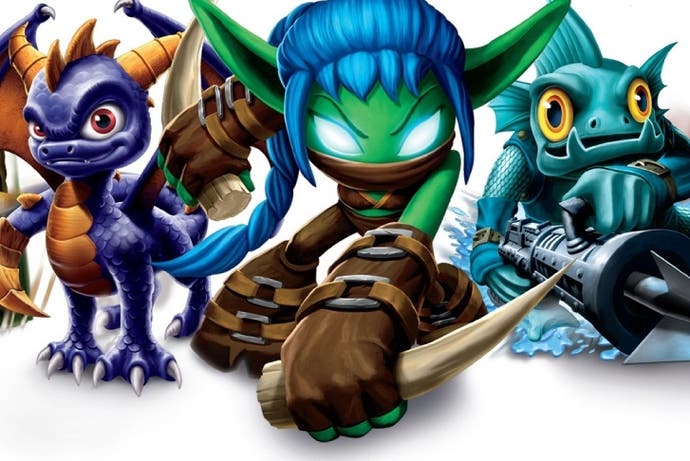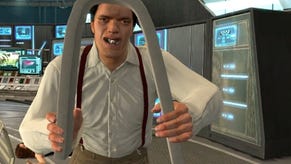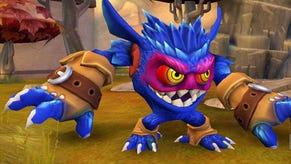Inside the toy box
Rediscovering the joy of play on a father-and-son visit to the home of the Skylanders.
"I've got a confession..."
It's never a good thing when your 10-year-old son starts a conversation like this.
"I wasn't that into Skylanders," he continues. This isn't much of a confession. Dillon is ten, almost eleven, and well into the transitional period where most boys start to feel torn between kid's stuff and more adult fare. His gaming diet used to be almost exclusively Lego games, Pokemon and, yes, Skylanders. Now he mostly plays Minecraft and Portal 2, and has started spending more time on Halo.
The confession is still expertly timed, however. We're on a plane, flying home from Toys for Bob, the studio that actually makes Skylanders, the game that he apparently wasn't that into. So, yeah, hell of a time to bring it up.
We've just spent the day as part of an international contingent of kid reporters at the Toys for Bob studio in Novato, California, just north up the 101 from San Francisco. From the outside, it's just another grey box in an industrial estate full of grey boxes, slowly baking in the Californian sun. Inside, it's a fantasia, a bustling and friendly place, the software equivalent of Wonka's factory. The Pacific Ocean is close by, and a Polynesian Tiki theme dominates the office, with every workstation housed inside a cosy wicker shelter.
]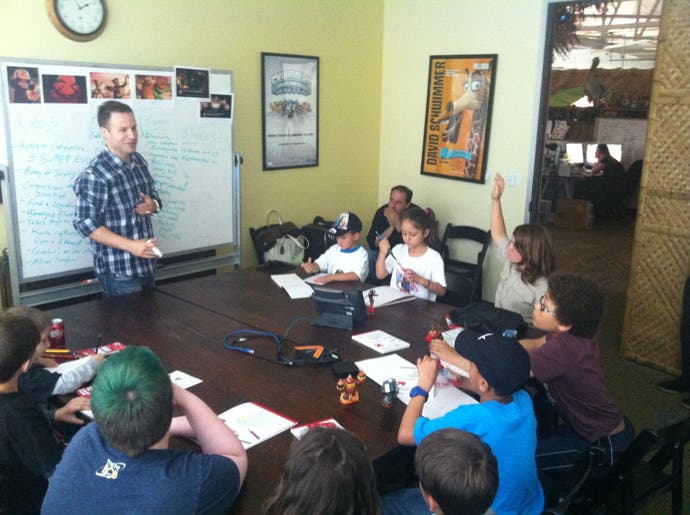
The obligatory avalanche of action figures, statues and models spills over every desk, drawn from every geek movie and TV franchise of note. And, of course, there are Skylanders. Everywhere. Skylanders still in their blister packs hang side by side from partitions, like so much 3D wallpaper. There's a large glass cabinet near the entrance, containing every iteration, from the first hand-made prototypes to the latest ultra-rare limited editions. Skylanders with variant paint jobs. Skylanders with a metallic sheen. Skylanders with furry flocked coatings. It's a treasure trove.
---
Dillon interviews: Alex Ness
Like many Toys for Bob employees, Alex Ness is a multitasker. The studio's Chief of Staff, he's also the lead writer on the Skylanders series and the voice of Drobot in the games.
Dillon: How important is writing on a game like Skylanders?
Ness: Sometimes it supports what everybody else is doing and sometimes it drives it. When you go from one level to the next level, the writing determines why you go there. What are you in this level to get? Who's this guy you meet? What's his deal? And then sometimes it's more that they've come up with a cool boat level and I have to think of something that ties in with that.
Dillon: Did you come up with the punny Skylander names?
Ness: About fifty people come up with those together, and we all have ideas. I think a few of the ones I submitted got in. It's funny how big a deal the names are. The CEO, the Head of Marketing, they'll go back and forth on email chains about the names. The things the characters say, though, that's me. And I do try to use puns. Sometimes it's hard to resist. [Alex picks up Dillon's Thumpback figure]. I mean, this guy? He's got to say something like "Anchors away!" or "Hail to the whale!", right?
Dillon: Do you have the Skylanders backstory all planned out and decide what to use for each game?
Ness: Yeah, to some degree. Sometimes it never gets used. It never hurts to do more, because you might pick out little things, stuff for later. Even if the player never notices, it's nice to have it there.
---
Toys for Bob is clearly very proud of its billion dollar franchise, and with good reason. In less than three years, the series has gone from nothing to one of the hottest kid's brands in the world. In the US, Skylanders toys now outsell Star Wars, WWE and Transformers. You can buy Skylanders birthday cakes, lunchboxes and spin-off novels. There are MegaBlox figures of the Skylanders figures. We're through the looking glass here.
Although Skylanders is what put the studio on the modern gaming map, it's been around since 1989, when it released the cult DOS game, Star Control. In the late 90s Toys for Bob was briefly owned by Crystal Dynamics, and worked on the excellent PlayStation platformer Pandemonium, before being bought out by Activision in 2005. Since then, it's developed games based on the Madagascar movies, a Disney game and a Tony Hawk spin-off, but nothing that would suggest it had a monster hit like Skylanders up its sleeve.
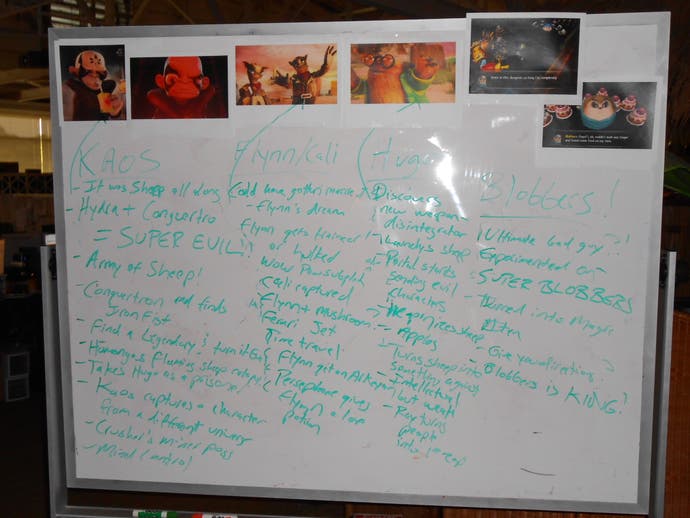
It's a phenomenon, then, and one with very organic and honest roots. Activision didn't come to Toys for Bob demanding a billion dollar toy franchise. Toys for Bob took the idea, hand-made prototypes and all, to Activision and gambled its future on its ingenuity. It's paid off, with a sense of personal investment in the brand that is evident across the studio. Many of the staff have named and even voiced the characters that now sell in the hundreds of thousands.
I've visited enough studios to spot the fatigue that comes from the development treadmill, the lack of engagement that comes from people who are just cogs in a machine, churning out product. I expect it, but I don't find it. At Toys for Bob, as groups of excited kids crowd around the desks of artists, level designers and coders, the employees are in no hurry for them to leave. "Any more questions?" is the common refrain after someone has been quizzed to within an inch of their life. "No? Anyone? C'mon, seriously? OK, well, let me show you this anyway..." If their passion is an act put on to placate their corporate masters, they deserve an Oscar.
---
Dillon interviews: I-Wei Huang
I-Wei Huang is the Toys for Bob concept artist, and the man ultimately responsible for the design of every Skylander, every NPC and every enemy.
Dillon: My favourite Skylander is Eye Brawl, and I was just wondering how you came up with him?
Huang: One of the designers had an idea, a gameplay idea, of an eyeball that pops out of a character's head and starts shooting lasers. It was so much fun that we decided we must make this character. He went through a lot of iterations. What if he had a really tiny head, or was really big, or a skeleton? At one point he was Egyptian. Lots of different iterations. It's very rare for a character to be, "I drew it, it's done." Sometimes it's a question of "Well, this doesn't work in this case but maybe for something else... This is a really cool weapon, but we can't use it for this character". There's a lot of things on the back burner. There's no shortage of ideas, it's just a question of which are good enough to make it into a Skylander.
Dillon: Did you always want to work in video games?
Huang: No. I always wanted to recreate life, so I studied to be an animator at first. I wanted to get into movies, because they look cool and games, at the time, didn't. This was before you were born. Then I realised that games are more fun to work on, and they're going to look better and better, and now some games look better than movies. I've just always wanted to create characters.
---
It's especially great to see kids at large in this environment. For many of the visitors, this is their first glimpse at how games are made, and they're wide-eyed at the glimpses they catch on monitors. The next Skylanders game, Swap Force, is being developed in New York by Vicarious Visions, so what is the game they're seeing here? It's a very sneaky top-secret preview of something they'll presumably be playing in 2014, a very distant future to kids who still measure time in lazy weekends and school holidays that last forever.

Their amazement at being behind the scenes is infectious. It's easy to get so hung up on reporting and reviewing games that we forget just how passionate kids can be about these things. To them, Skylanders isn't just a product to be coolly studied and dissected. It's the coolest thing on Earth, something to immerse yourself in. I feel sadly nostalgic watching them. This, I realise, is how I would have felt if I'd visited LucasFilm or the Marvel bullpen in the 1980s.
Dillon has yet to drop his confession on me, but I already know it's nonsense. I've not seen him play Skylanders for months, but in the company of enthusiasts ranging from six-years-old to early teens, from the UK, US and France, he immediately joins in with detailed conversations about the relative merits of different characters he doesn't even own. That investment, that passion, is still there. That's what it means to be a kid, to be so into something that it fills you completely. This is why there are Skylanders cakes and t-shirts. This is why Activision doesn't make a Skylanders movie or TV show. There's no need.
---
Dillon interviews: Paul Reiche
Paul Reiche is Toys for Bob's president and the creative director of the Skylanders series. A veteran of TSR, where he worked with Gary Gygax, he co-founded Toys for Bob in 1989.
Dillon: What's it like running a large studio like Toys for Bob?
Reiche: You need to think about what you want the future to be like, you need to make sure that all the people you work with want the same future, and once you all agree, then everybody charges off in the same direction. Sometimes, on a really god day, I get to go and sit with I-Wei and design Skylanders. That's my favourite part of the job.
Dillon: Why can't any of the air element Skylanders actually fly?
Reiche: What we found was that people were spending a lot of effort just trying to fly around. While that's interesting if you're making a flying game, what we were making was a combat adventure, and so what we decided to do was find a style of movement that was as easy and intuitive to use as possible. That's why we ended up making flying very low to the ground.
Dillon: Why is the office Tiki themed?
Reiche: I had just been down to Disneyland, and they have Adventureland, which isn't Tiki-themed exactly, but it has this sense of being in an exotic country where anything can happen. That really appealed to me, something that would inspire people's imaginations, but also feel very natural. Working in a very sterile, square environment can actually be uncomfortable. We evolved to be outside. People are most creative when they're in environments like that.
---
"I have a confession. I wasn't that into Skylanders," Dillon tells me as we fly home. "But now I really like it again."
I was wary about bringing him on this trip. I was wary of a child's enthusiasm - my child's enthusiasm - being exploited by a multinational company. In the end, I decided that it wouldn't be fair to let my concerns hold him back from a pretty amazing opportunity, and just told him to be honest and open in his questions, and in his reactions to what he saw.
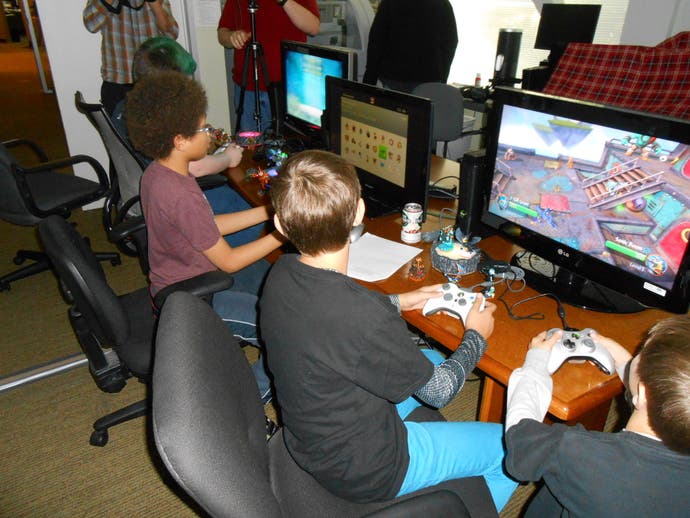
In the end, it feels irrelevant. I'm under no illusions that Activision gets what it wants from events like this - lots of juicy word of mouth from its target audience - but I'm also won over by the fact that Toys for Bob doesn't feel like the growling engine behind a ruthless franchise machine. Entertaining children is a privilege, and it's clear that the studio takes that seriously.
That's why Skylanders has struck such a chord with young gamers. It doesn't feel like it's been precision-tooled in a sterile demographic laboratory. It's a weird series, populated by an expanding cast of characters who often share little in common between being really cool or silly. It feels like something that was doodled in a tattered schoolbook, not to make a billion dollars, but because the idea of toys that come to life in a game was too awesome to ignore.
I really like Skylanders, too, although I still feel it's at least one iteration away from truly seizing its full gameplay potential. It's good, at least, to know that something enjoyed by millions of children is being made by people who care about what they're doing. Can that idealism survive the annual sequels demanded by today's gaming market? I genuinely hope so.
It's a long flight home. Dillon fidgets and shuffles in his seat, but eventually falls asleep. Clutched in his hand, staring back at me, is Thumpback.
This article is based on a press trip to Toys for Bob's offices in California. Activision paid for travel and accommodation.
